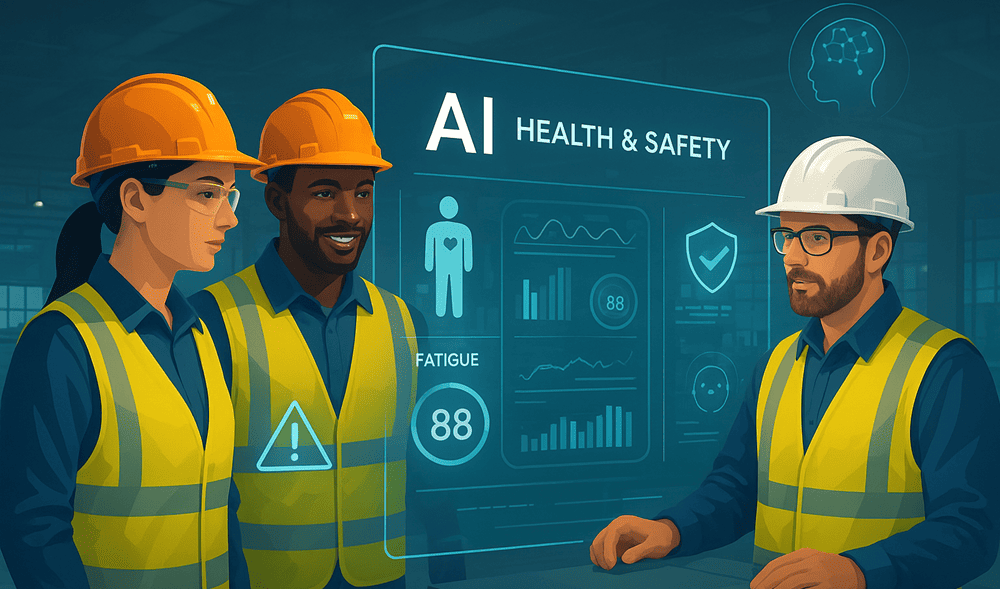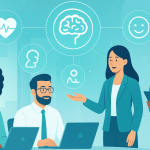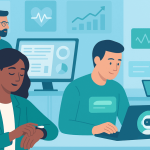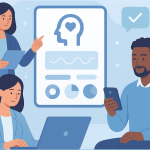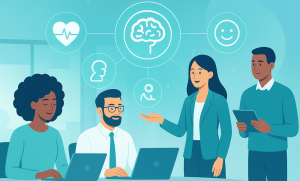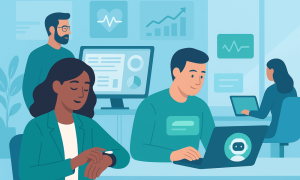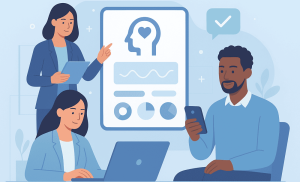In recent years, the convergence of health, safety, and technology has opened new pathways to protect workers while optimizing operations. For business leaders and safety professionals, integrating occupational health AI into OHS (Occupational Health & Safety) strategies offers a way to shift from reactive measures to predictive, preventive systems. In this post, we’ll examine how OHS wellness AI, workplace safety AI, and related approaches can reduce risk, support occupational fatigue prevention, and embed wellbeing in safety programs.
Why AI Matters for Occupational Health & Safety
The scale of the challenge
- Globally, about 2.78 million worker deaths each year and 374 million nonfatal occupational injuries and illnesses impose enormous social and economic costs.
- In the U.S. alone, workplace injuries cost over $167 billion annually (2022 data)
- Traditional safety systems often lag behind emerging risks, human observation, manual audits, and lagging indicators leave gaps.
These pressures make it clear: evolving your safety and health program to include AI is no longer optional; it’s strategic.
What is “occupational health AI”?
At its core, occupational health AI refers to systems that apply machine learning, predictive analytics, computer vision, and sensor integration to detect, predict, or respond to safety and health risks in the workplace. These systems can comb through large datasets — environmental, biometric, incident history, behavior logs — and reveal patterns invisible to human analysis.
In effect, AI becomes a partner in your safety management system, helping you spot emerging hazards, anticipate fatigue, and nudge behavior before an incident occurs.
Key Use Cases of AI in Occupational Health & Safety
Below are high-impact use cases where occupational health AI is making real-world differences:
| Use Case | Description | Outcomes & Examples |
| Real-time hazard detection | Using camera feeds, computer vision, and environmental sensors to spot unsafe conditions (slips, obstacles, blocked aisles, PPE noncompliance) | Reductions in incidents, proactive alerts; AI vision systems catching hazards before human inspection would. |
| Predictive analytics / risk forecasting | Training models on historical incident and environmental data to forecast where and when accidents may occur | Some clients report 25% fewer incidents after deploying predictive systems. |
| Wearables & fatigue monitoring | Devices capturing biometric data (heart rate variability, motion, posture) and feeding AI models to flag fatigue or musculoskeletal stress | In transport, shift work, and manufacturing fields, AI + wearables have been used to reduce fatigue-related events. |
| Ergonomics and biomechanical risk | Combining anthropometric data with sensor inputs to assess posture, repetition, strain | AI-driven ergonomics tools show fewer musculoskeletal injuries and lower downtime. |
| Smart scheduling & fatigue risk assessment | Integrating fatigue models into shift planning to avoid overwork, optimize rest periods, and align shifts with worker physiology | Some platforms claim up to 65% reduction in safety incidents when fatigue-aware scheduling is adopted. |
| OHS compliance & automation | Automating audit routines, regulatory checks, and documentation generation, freeing up safety staff | AI helps maintain consistent compliance tracking, enforce policies, and generate reports. |
Together, these applications enable a shift from “incident response” to incident prevention — a more resilient, efficient, and worker-centric safety posture.
How AI Supports Occupational Fatigue Prevention
Fatigue plays a silent but powerful role in many workplace incidents. For high-risk operations or extended shifts, fatigue can dramatically increase error rates and near-miss events. Integrating AI into fatigue management is a game changer.
What AI brings to fatigue prevention
- Predictive fatigue models
AI models can correlate work patterns, rest intervals, workload intensity, biometric data, and environmental conditions to generate individual fatigue risk scores. - Real-time alerts
When signs of fatigue (micro-delays in movement, slow reactions) appear, AI can trigger warnings or recommend breaks or task shifts to safer duties. - Adaptive scheduling
AI can dynamically adjust scheduling to avoid “danger zones” of cumulative fatigue by distributing load or adjusting shift patterns. - Personalized feedback and training
Using feedback loops, AI can suggest individual best practices (timing breaks, micro-rest, shift swap) tuned to each worker’s fatigue profile.
Evidence & benefits
- In pilot studies, organizations adopting AI fatigue assessment reported incident reductions in the 30–70% range.
- Wearable + AI systems in transportation and shift work sectors show strong correlation between AI fatigue flags and actual safety events.
- AI-driven fatigue scheduling can also reduce absenteeism (as fatigue contributes to burnout and health issues), and improve overall operational stability.
In short, AI becomes a strategic enabler of occupational fatigue prevention — not as a monitoring tool, but as a decision support system that helps your workforce stay alert and safe.
Integrating Occupational Health AI into a Safety Strategy
You can’t just flip a switch and let AI run your safety program. Thoughtful implementation is key to success.
Step-by-step integration path
- Assess readiness & define goals
Begin by evaluating existing safety data, incident logs, sensor infrastructure, and gaps. Define KPIs (e.g. incident rate, near-miss reduction, lost-time injuries). - Start pilot projects
Deploy AI tools in high-risk zones or specific departments (e.g. production lines, logistics) rather than full-scale rollout. Use learnings to refine models. - Ensure data infrastructure & quality
AI is only as good as its data. Set up clean, secure pipelines (sensors, IoT, wearables) and align formats and standards. - Adopt a human-in-the-loop approach
Let AI suggest actions; let safety staff validate them. Humans remain central — decisions shouldn’t be relegated wholly to “black box” systems. - Address privacy, bias & ethics
Be transparent about data use, anonymize where possible, explain model logic (explainable AI), and guard against algorithmic bias. - Train users and build acceptance
Involve workers, safety champs, and supervisors in training. Show them how AI work life balance features or fatigue alerts aid them, not police them. - Measure, refine, expand
Monitor KPIs, gather feedback, retrain models, and gradually extend across business units.
Key enablers and pitfalls
- Leadership buy-in is essential — without visible support, adoption will stall.
- Change management must accompany tech rollout (culture, trust, roles).
- Model drift and retraining: AI models may degrade over time — continuous maintenance is needed.
- Integration with legacy systems: Ensure AI tools can connect with ERP, HR, timekeeping, etc.
- Scalability: Start small and expand modularly.
How AI Reduces Health & Safety Risks (AI Risk Reduction Health)
By embedding AI into safety and health programs, organizations can tackle a wide spectrum of risk vectors more proactively:
- Early warning signals: AI detects subtle precursors to incidents (e.g. deviating motion patterns, abnormal vibrations, micro-slips).
- Root cause insights: AI analytics can correlate varied data sources to surface hidden systemic issues (e.g. workflow bottlenecks, cumulative stress).
- Resource prioritization: Instead of blanket audits, direct safety resources to zones or tasks with highest predicted risk.
- Continuous improvement: With ongoing learning, AI adapts and improves, contributing to a feedback loop of safer design.
- Worker health linkage: AI supports broader health monitoring (fatigue, ergonomics, stress), so safety and wellbeing are no longer siloed.
In sum, AI risk reduction health becomes an integral dimension of your OHS framework rather than an afterthought.
Embedding Wellbeing in Safety Programs
Safety programs have traditionally focused on physical risk reduction. But workers’ health, wellness, and mental resilience are equally important. AI helps bridge that gap.
- Use OHS wellness AI to monitor not just injury risk, but health signals like elevated strain, irregular biometrics, or stress markers.
- Integrate wellness data (voluntarily and anonymously) into wellbeing in safety programs, letting you tailor interventions (e.g. microbreak prompts, ergonomic adjustments, mindfulness nudges).
- With AI helping maintain AI mindfulness reminders or pause suggestions, you can prevent cognitive overload, fatigue, and burnout.
- Combine with reduce absenteeism initiatives: when AI flags elevated risk or fatigue in individuals, targeted outreach or rest planning may reduce unplanned absences.
- Leverage burnout forecasting AI to predict which employees are trending toward overload or burnout — enabling pre-emptive support.
- Deploy holistic employee wellbeing solution suites that tie safety, health, mental wellness, and performance together.
- Design or integrate workplace wellbeing program elements (e.g. micro-breaks, resilience training) guided by AI-driven data.
In effect, AI lets you treat safety and wellbeing as two sides of the same coin: protecting workers physically and holistically.
Addressing Challenges & Objections
No technology is without risk. Here’s how to anticipate and mitigate common objections:
| Objection | Response / Mitigation |
| “AI is invasive / violates privacy” | Be transparent in data use, anonymize data, limit to non-identifiable signals, seek consent, and use explainable models. |
| “Black box / lack of trust” | Use explainable AI models, show logic, involve safety teams in decision loops. |
| “Cost and ROI concerns” | Start with pilots in highest-risk areas; many organizations see ROI via reduced incidents, lower claims, and productivity gains. |
| “Skepticism from workforce” | Engage workers early, communicate benefits (not surveillance), emphasize AI work life balance and wellbeing support. |
| “Algorithmic bias or errors” | Monitor for bias, retrain models, validate with domain experts, and ensure human oversight. |
| “Technical integration issues” | Use modular, API-friendly systems; plan for data pipelines, legacy interoperability. |
| “Model drift / decay” | Maintain continuous learning, periodic retraining, and monitoring performance metrics. |
If these challenges are addressed deliberately, the benefits of AI in occupational health can outweigh potential risks.
Metrics & KPIs to Track
When you launch an AI-powered OHS program, track indicators to validate whether it’s delivering:
- Incident rate (per 100 workers) before vs. after AI
- Near-miss trend rates
- Lost-time injury frequency
- Safety audit scores
- Overtime or fatigue-related events
- Absenteeism / unplanned leave (ties to fatigue or burnout)
- Worker satisfaction or trust in safety programs
- ROI: claims costs, insurance premiums, productivity gains
Use dashboards to compare AI predictions vs. actual outcomes, and refine models over time.
Conclusion
AI in occupational health and safety is rapidly shifting from a futuristic concept to a practical necessity. When implemented thoughtfully, occupational health AI can transform how organizations manage risk, prevent fatigue and injuries, and embed healthier, more resilient cultures into operations.
By combining OHS wellness AI, workplace safety AI, fatigue prevention systems, and risk-reduction health analytics, you can move your safety program from reactive to proactive. And by integrating wellness, mental health, and safety, with features like AI mindfulness, burnout forecasting AI, and integrated employee wellbeing solution modules, you can deliver a truly holistic safety-wellness program.

